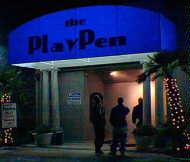


E.S.S. Entertainment 2000, Inc. v. Rock Star Videos, Inc., --- F.Supp.2d ---, 2006 WL 2258336 (C.D. Cal.). Trademark Blog discussion here.
Plaintiff does business as the Play Pen Gentlemen’s Club, an adult-oriented entertainment business at the eastern edge of downtown
The parties sniped over whether GTA games are known for “parody” or simply “irreverent humor” (this, I take it, means that shooting people and brutalizing prostitutes in the game is good, point-earning fun). The court, following 9th Circuit precedent, holds that the presence of parody is a matter of law for the court to decide.
Los Santos mimics the look and feel of actual
The court set forth a number of differences between the overall look of the clubs and differences in the parties’ markets; concluded that both strip club consumers and video game consumers are relatively sophisticated in that they know what they want; and noted defendant’s consumer survey showing essentially no confusion.
It then rejected the nominative fair use defense. In order to avail itself of this defense, the defendant must in fact be talking about the plaintiff, and the defendant argued that it was depicting and mocking strip clubs in general, rather than the plaintiff. I can see situations where a user ought to be able to pick a particular instance of a general type and then distort that in order to mock the overall category, so I’m not thrilled with this outcome – but see next paragraph.
The court’s nominative fair use analysis is in some tension with the court’s simultaneous conclusion that the game was entitled to extra leeway in the confusion analysis because of First Amendment concerns. The court found that the Pig Pen has artistic relevance to the game’s “twisted, irreverent” image of urban
Because there was artistic relevance and defendant didn’t make any explicit misrepresentations about the Play Pen, defendant prevailed. The court suggested that, given that the Pig Pen is hidden in the game, deception is less likely than it was in Rogers v. Grimaldi or Mattel v. MCA Records, where titles were involved. Given the extent of product placement in video games these days, I’m not sure that distinction is justified – the court cites false advertising cases noting that a representation on materials hidden in the package can’t affect a purchase decision, but on the trademark side courts have been willing to recognize post-sale confusion and harm to a plaintiff’s goodwill in similar circumstances. That’s not to say the decision was wrong – it’s plainly right – but basically the court overthought the whole thing, as a perusal of the very long opinion will show.
No comments:
Post a Comment